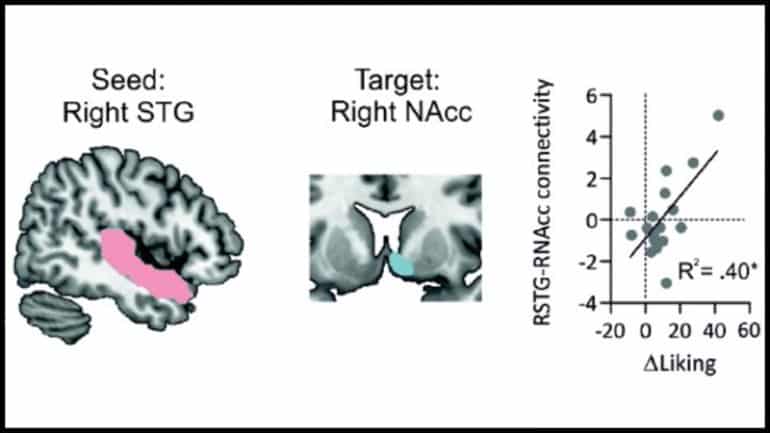Summary: Interaction between auditory areas of the brain and the reward system drive pleasure when we listen to music.
Source: SfN
Communication between the brain’s auditory and reward circuits is the reason why humans find music rewarding, according to new research published in Journal of Neuroscience.
Despite no obvious biological benefits, humans love music. Neuroimaging studies highlight similarities between how the brain’s reward circuits process music and other rewards like food, money, and alcohol. Yet neuroimaging studies are correlational by nature.
In a new study, Mas-Herrero et al. sought to nail down the causal role of this circuitry by using non-invasive brain stimulation.
A group of pop music fans listened to a set of pop songs while the research team measured their brain activity with fMRI. Before the scan, the team indirectly excited or inhibited the brain’s reward circuit with transcranial magnetic stimulation.

Exciting the reward circuit prior to hearing music increased the pleasure participants felt when listening to the songs, while inhibiting it decreased pleasure. These induced pleasure changes were linked to changes in activity in the nucleus accumbens, a key region of the reward circuit.
The participants with the greatest difference in pleasure also showed the greatest difference in synchronized activity between auditory and reward regions.
These results indicate interactions between auditory and reward regions drive the pleasure we feel when listening to music.
About this music and neuroscience research news
Source: SfN
Contact: Calli McMurray – SfN
Image: The image is credited to Mas-Herrero et al., JNeurosci 2021
Original Research: Closed access.
“Unraveling the Temporal Dynamics of Reward Signals in Music-Induced Pleasure with TMS” by Ernest Mas-Herrero, Alain Dagher, Marcel Farrés-Franch and Robert J. Zatorre. Journal of Neuroscience
Abstract
Unraveling the Temporal Dynamics of Reward Signals in Music-Induced Pleasure with TMS
Music’s ability to induce feelings of pleasure has been the subject of intense neuroscientific research lately. Prior neuroimaging studies have shown that music-induced pleasure engages cortico-striatal circuits related to the anticipation and receipt of biologically relevant rewards/incentives, but these reports are necessarily correlational.
Here, we studied both the causal role of this circuitry and its temporal dynamics by applying Transcranial Magnetic Stimulation (TMS) over the left dorsolateral prefrontal cortex combined with functional Magnetic Resonance Imaging (fMRI) in 17 male and female participants. Behaviorally, we found that, in accord with previous findings, excitation of fronto-striatal pathways enhanced subjective reports of music-induced pleasure and motivation; whereas inhibition of the same circuitry led to the reduction of both.
fMRI activity patterns indicated that these behavioral changes were driven by bidirectional TMS-induced alteration of fronto-striatal function. Specifically, changes in activity in the nucleus accumbens (NAcc) predicted modulation of both hedonic and motivational responses, with a dissociation between pre-experiential vs. experiential components of musical reward. In addition, TMS-induced changes in the fMRI functional connectivity between the NAcc and frontal and auditory cortices predicted the degree of modulation of hedonic responses.
These results indicate that the engagement of cortico-striatal pathways and the NAcc, in particular, is indispensable to experience rewarding feelings from music.
SIGNIFICANCE STATEMENT:
Neuroimaging studies have shown that music-induced pleasure engages cortico-striatal circuits involved in the processing of biologically relevant rewards. Yet, these reports are necessarily correlational.
Here, we studied both the causal role of this circuitry and its temporal dynamics by combining brain stimulation over the frontal cortex with functional imaging.
Behaviorally, we found that excitation and inhibition of fronto-striatal pathways enhanced and disrupted, respectively, subjective reports of music-induced pleasure and motivation. These changes were associated with changes in nucleus accumbens (NAcc) activity and NAcc coupling with frontal and auditory cortices, dissociating between pre-experimental vs. experiential components of musical reward.
These results indicate that the engagement of cortico-striatal pathways, and the NAcc in particular, is indispensable to experience rewarding feeling from music.






